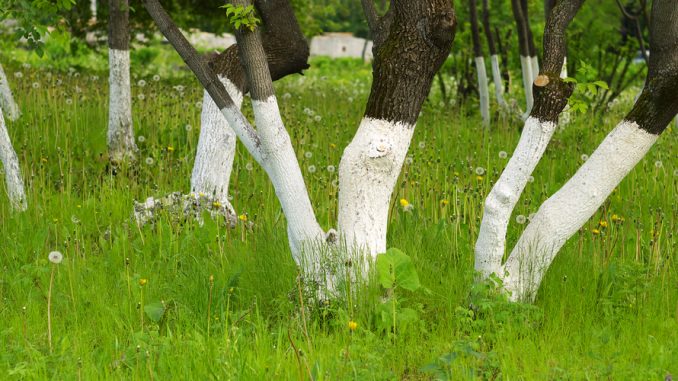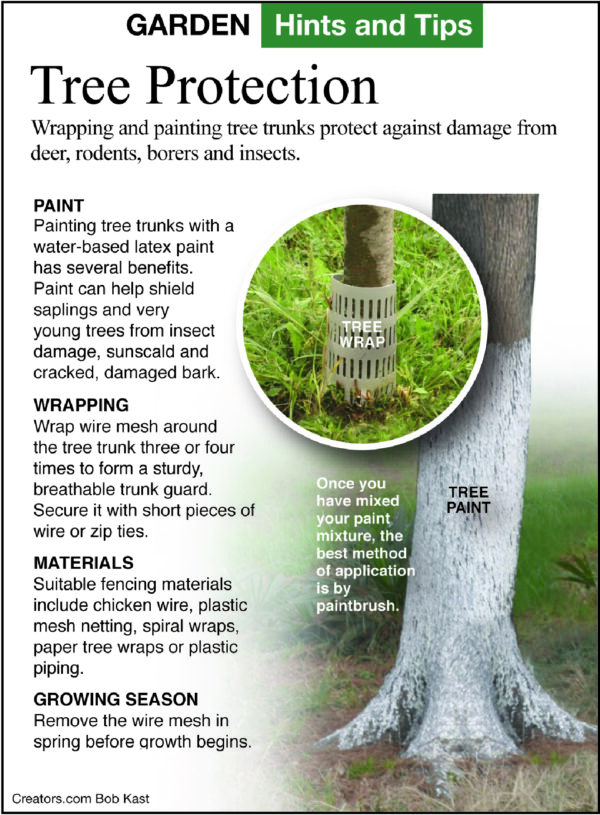
Q: I am planting some 6- to 10-foot-tall fruit trees and a couple of small shade trees. Is there really a benefit to painting the tree trunks or wrapping them in that spiral wrap stuff?
A: How many trees do you see in nature that are painted or wrapped? Tree trunks don’t normally need to be painted or wrapped in plastic pipe, wire, or cloth. However, there are times when tree wrap can help protect the tree.
Trees have bark to protect the live cambium tissue growing right under the bark. This cambium tissue needs protection from mammals eating it, from insects boring through it, and from sunlight heating it or sunburning it with ultraviolet light.
When a tree grows from a seed in a sunny location, it produces thicker bark on the sunny side of the tree. When we buy a tree that was growing in a field, we rarely plant it facing the same direction it was growing in the field. The small trees you are planting are probably growing in pots and have been moved so many times no one can know which way they were oriented in the past.
Sunlight can damage the cambium layer if a tree is planted so the thin side of bark is oriented toward the sun. The damage is called sunscald. Trees growing close together in a field shade each other, but when they are planted by themselves in a landscape, the trunk may be exposed to the sun. Sunscald can also happen if a lot of low branches are pruned off a tree.
Ultraviolet light can damage the tree in the spring and summer. During the winter, the sun warms the south- or southwest-facing side of the trunk during cold winter days. The cells begin to grow as they warm up in the sunshine, and they start consuming their antifreeze sugars. Within hours, water in the cells freezes at night as the temperature drops below freezing and the cells have less sugar to use as antifreeze. Ice in the cells and between the cells ruptures the cells, and that area of cambium cells dies. That side of the trunk may develop a large crack called a frost crack.
Sunscald and frost cracks are more likely to develop on thin, barked trees such as beech, birch, cherry, maple, and small fruit trees. The problem with painting or wrapping newly planted trees is that they may not grow their own protective layer of thicker bark very quickly. The warmer and sunnier the climate, the more likely the trees will need protection from sunscald from painting or wrapping. And the colder the climate, the more likely the trees will need protection from sunscald and frost cracks. Wrap young and newly planted trees each fall and unwrap them each spring until the bark develops a thick layer.
Trees with thin bark may be nibbled on by rodents, especially in regions with heavy snow cover. Each fall, thin-barked trees and fruit trees can be wrapped in wire mesh, cloth, or paper tree wraps to prevent rodent damage. The wraps should be removed in the spring to prevent insects and disease organisms from hiding behind the wrap and damaging the tree.
Thin-barked trees can be protected from rabbits and some boring insects by painting the trunks. Use a latex paint. Oil paints can be toxic to trees. You can use the paint right out of the can, or you can dilute the paint up to 1 part paint and 4 parts water. The thicker the paint, the more protection there is. There are companies that make tree trunk paint that you can find online.
When a tree has thick bark, it does not need to be protected by paint. Rows of large street trees are painted because someone thinks they look pretty.
Email questions to Jeff Rugg at info@greenerview.com. To find out more about Jeff Rugg and read features by other Creators Syndicate writers and cartoonists, visit the Creators Syndicate website at Creators.com. Copyright 2021 Jeff Rugg. Distributed by Creators Syndicate.






Be the first to comment